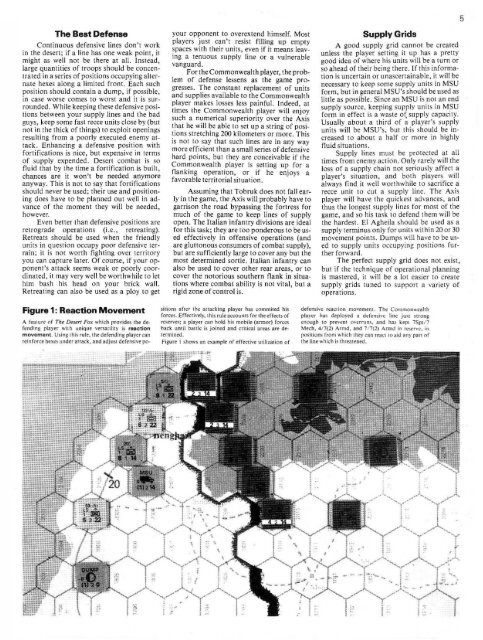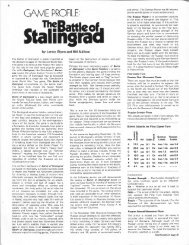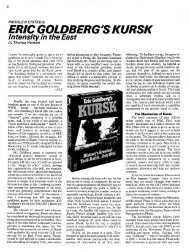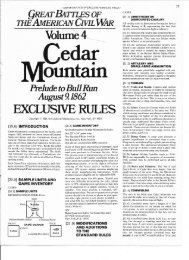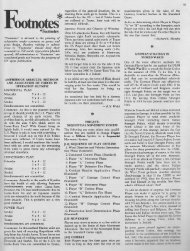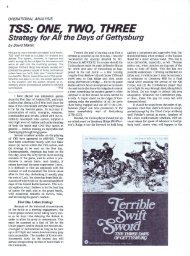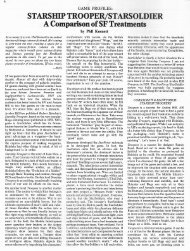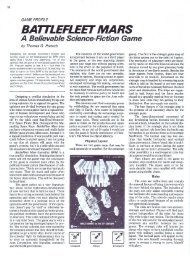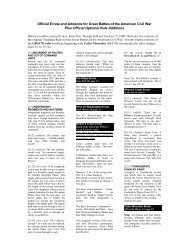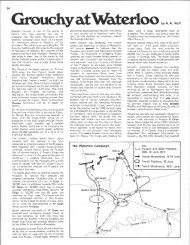DOCTRINE FOR DESERT FOX - RussGifford.net
DOCTRINE FOR DESERT FOX - RussGifford.net
DOCTRINE FOR DESERT FOX - RussGifford.net
Create successful ePaper yourself
Turn your PDF publications into a flip-book with our unique Google optimized e-Paper software.
The Best Defense<br />
Continuous defensive lines don't work<br />
in the desert; if a line has one weak point, it<br />
might as well not be there at all. Instead,<br />
large quam.ities of troops should be concentrated<br />
in a series of positions occupying alternate<br />
hexes along a limited front. Each such<br />
position should contain a dump, if possible,<br />
in case worse comes to worst and it is surrounded.<br />
While keeping these defensive positions<br />
betl','een your supply lines and the bad<br />
guys, keep some fast recce units close by (but<br />
not in the thick of things) to exploit openings<br />
resulting from a poorly executed enemy attack<br />
. Enhancing a defensive position with<br />
fortifications is nice, but expensive in terms<br />
of supply expended. Desert combat is so<br />
fluid that by the time a fortification is built,<br />
chances are it won't be needed anymore<br />
anyway. This is not to say that fortifications<br />
should never be used; their use and positioning<br />
does have to be planned out well in advance<br />
of the moment they will be needed,<br />
however.<br />
Even better than defensive positions are<br />
ret rograde operations (i.e., retreating).<br />
Retreats should be used when the friendly<br />
units in question occupy poor defensive [errain;<br />
it is not worth fighting over t.errilOry<br />
you can capture later. Of course, if your opponent's<br />
attack seems weak or poorly coordinated,<br />
it may very well be worthwhile [0 let<br />
him bash his head on your brick wall.<br />
Retreating can also be used as a ploy to get<br />
A feature of The Desert Fox which provides the defend<br />
ing player with unique versatility is reaction<br />
movement. Using Ihi. rule. the defending player can<br />
rein force hexes under anack, and adjust defensive poyour<br />
opponent to overextend himself. Most<br />
players just can't resist filling up empty<br />
spaces with their units, even if it means leaving<br />
a tenuous supply line or a vulnerable<br />
vanguard,<br />
For the Commonwealth player, the problem<br />
of defense lessens as the game progresses.<br />
The constant replacement of units<br />
and supplies available to the Commonwealth<br />
player makes losses less painful. Indeed, at<br />
times the Commonwealth player will enjoy<br />
such a numerical superiority over the Axis<br />
thal he will be able to set up a string of positions<br />
stretching 200 kilometers or more. This<br />
is not to say that such lines are in any way<br />
more efficient than a small series of defensive<br />
hard points, but they are conceivable if [he<br />
Commonwealth player is setting up for a<br />
flanking operation, or if he enjoys a<br />
favorable territorial situation.<br />
Assuming that Tobruk does not fall early<br />
in the game, the Axis will probably have to<br />
garrison the road bypassing the fortress for<br />
much of the game to keep lines of supply<br />
open. The Italian infantry divisions are ideal<br />
for this task; they are too ponderous to be used<br />
effectively in offensive operations (and<br />
are gluttonous consumers of combat supply),<br />
but are sufficiently large to cover any but the<br />
most determined sortie. Italian infantry can<br />
also be used to cOver other rear areas, or to<br />
cover the notorious southern flank in situations<br />
where combat ability is not vital, but a<br />
rigid zone of control is.<br />
Supply Grids<br />
A good supply grid cannot be created<br />
unless the player setting it up has a pretty<br />
good idea of where his units will be a turn or<br />
so ahead of their being there. If this information<br />
is uncertain or unascertainable, it will be<br />
necessary to keep some supply units in MSU<br />
form, but in general MSU's should be used as<br />
little as possible. Since an MSU is not an end<br />
supply source, keeping supply units in MSU<br />
form in effect is a waste oC supply capacity.<br />
Usually about a third of a player's supply<br />
units will be MSU's, but this should be increased<br />
to about a half or more in highly<br />
fluid situations.<br />
Supply lines must be protected at all<br />
times from enemy action. Only rarely will the<br />
loss of a supply chain not seriously affect a<br />
player's situation, and both players will<br />
always find it well worthwhile to sacrifice a<br />
recce unit to cut a supply line . The Axis<br />
player will have the quickest advances, and<br />
thus the longest supply lines for most of the<br />
game, and so his task to defend them will be<br />
the hardest. El Agheiia should be used as· a<br />
supply terminus only for units wit hin 20 or 30<br />
movement points. Dumps will have to be used<br />
to supply units occupying positions further<br />
forward .<br />
The perfect supply grid does not exist,<br />
but if the technique of operational planning<br />
is mastered, it will be a lot easier to create<br />
supply grids tuned to support a variety of<br />
operations.<br />
5<br />
Figure 1: Reaction Movement<br />
sitions afler the anacking player has commiled his<br />
forces. Effecti\'ely, Ihis rule ac of<br />
reserve.; a player can hold his mobile (armOr) forces<br />
hack umil banlc is joined and crilical areas are de·<br />
termined.<br />
Figure t shows an example of effeclive ulilizacion or<br />
defensive rea cl ion movement. The Cornmonwcalth<br />
player has deployed a defensive lin e jusl strong<br />
enough 10 prevent overruns. and has kept 7Sptn<br />
Mech, 417(2) Arrnd. and 7!i(2) Arm" in reserve, in<br />
pos it io ns from whic h Ihey can reael 10 aid any pan of<br />
Ihe tine which is Ihrealened .


